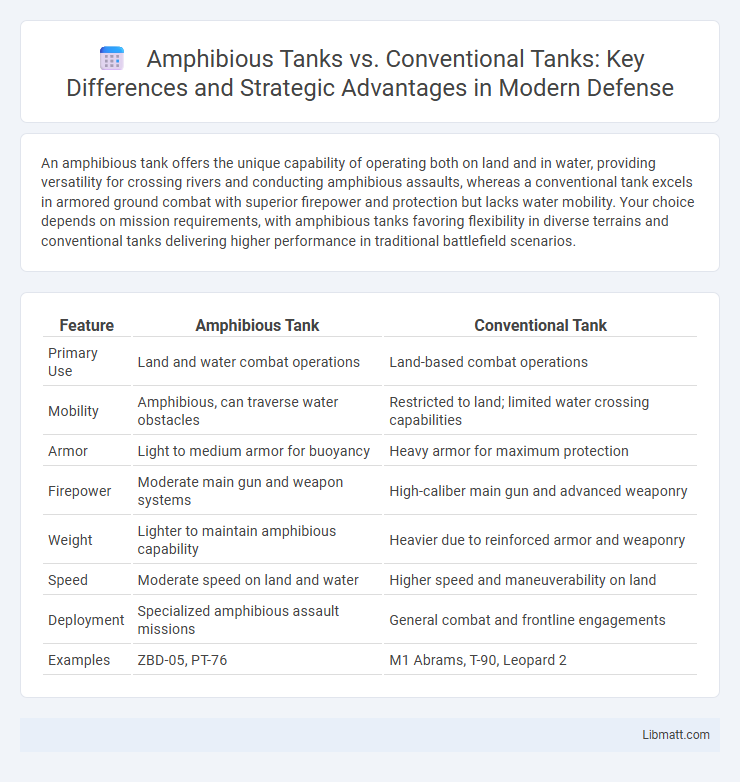An amphibious tank offers the unique capability of operating both on land and in water, providing versatility for crossing rivers and conducting amphibious assaults, whereas a conventional tank excels in armored ground combat with superior firepower and protection but lacks water mobility. Your choice depends on mission requirements, with amphibious tanks favoring flexibility in diverse terrains and conventional tanks delivering higher performance in traditional battlefield scenarios.
Table of Comparison
| Feature | Amphibious Tank | Conventional Tank |
|---|---|---|
| Primary Use | Land and water combat operations | Land-based combat operations |
| Mobility | Amphibious, can traverse water obstacles | Restricted to land; limited water crossing capabilities |
| Armor | Light to medium armor for buoyancy | Heavy armor for maximum protection |
| Firepower | Moderate main gun and weapon systems | High-caliber main gun and advanced weaponry |
| Weight | Lighter to maintain amphibious capability | Heavier due to reinforced armor and weaponry |
| Speed | Moderate speed on land and water | Higher speed and maneuverability on land |
| Deployment | Specialized amphibious assault missions | General combat and frontline engagements |
| Examples | ZBD-05, PT-76 | M1 Abrams, T-90, Leopard 2 |
Introduction to Amphibious and Conventional Tanks
Amphibious tanks are engineered to operate both on land and in water, featuring specialized waterproof hulls and propulsion systems to navigate aquatic environments effectively. Conventional tanks are designed primarily for terrestrial combat, emphasizing heavy armor, firepower, and mobility on solid ground. Understanding the distinct capabilities of amphibious tanks versus conventional tanks helps you assess their strategic roles in diverse battlefield scenarios.
Key Design Differences
Amphibious tanks feature watertight hulls, buoyancy aids, and propulsion systems such as water jets or propellers, enabling seamless water navigation, unlike conventional tanks designed primarily for land combat with heavier armor and tracks optimized for rough terrain. The lightweight construction and sealed components of amphibious tanks compromise some armor thickness to maintain buoyancy and maneuverability in aquatic environments. Your choice depends on mission requirements, balancing amphibious versatility against the superior firepower and armor protection of conventional land tanks.
Mobility and Terrain Adaptability
Amphibious tanks excel in mobility by seamlessly transitioning between water and land, enabling operations across rivers, swamps, and coastal areas where conventional tanks struggle. Their specialized hull designs and propulsion systems provide superior adaptability in diverse terrains, including wetlands and flood-prone zones. Your strategic advantage increases with amphibious tanks due to their unique capability to expand battlefield accessibility beyond traditional ground constraints.
Armament and Firepower Comparison
Amphibious tanks are typically equipped with lighter armament such as medium-caliber cannons and machine guns to maintain buoyancy and maneuverability in water, sacrificing some firepower compared to conventional tanks. Conventional tanks feature heavier main guns, often 120mm or larger, with advanced targeting systems designed for maximum offensive capabilities on land. Your choice between these tanks depends on mission requirements, balancing firepower with amphibious versatility.
Armor and Protection Features
Amphibious tanks prioritize lighter armor to maintain buoyancy and enable water traversal, often featuring corrosion-resistant coatings and watertight seals for protection against aquatic elements. Conventional tanks boast heavier, composite armor with reactive and modular systems designed to withstand kinetic projectiles, explosives, and chemical threats on land. Your choice should consider whether enhanced mobility in water outweighs the reduced armor protection inherent to amphibious models.
Amphibious Capabilities in Modern Warfare
Amphibious tanks provide unique operational advantages by enabling seamless transitions between land and water, crucial for cross-river assaults and coastal operations in modern warfare. Their ability to traverse water obstacles without the need for external support significantly enhances tactical mobility and expeditionary force flexibility. Your choice of an amphibious tank over a conventional tank can dramatically improve mission success in diverse combat environments where waterborne maneuverability is key.
Operational Roles and Mission Flexibility
Amphibious tanks excel in operational roles requiring seamless transition between land and water, enabling rapid beach assaults, river crossings, and coastal defense missions that conventional tanks cannot perform without support. Their mission flexibility includes reconnaissance and securing waterborne supply routes, providing combined arms forces with enhanced mobility and surprise in littoral environments. Conventional tanks dominate in sustained armored engagements and heavy firepower roles but lack the amphibious capability critical for multi-domain operations involving water obstacles.
Limitations and Vulnerabilities
Amphibious tanks face limitations such as reduced armor thickness and firepower compared to conventional tanks, making them more vulnerable in heavy combat situations. Their swimming mechanisms often compromise speed and agility on land, limiting battlefield effectiveness. Your tactical use should account for these vulnerabilities, deploying amphibious tanks primarily in river crossings and amphibious assaults rather than prolonged ground engagements.
Notable Examples and Service History
The Soviet PT-76 amphibious tank, introduced in the early 1950s, became a significant asset in river-crossing operations and saw extensive use during the Vietnam War. In contrast, conventional tanks like the American M1 Abrams and German Leopard 2 have dominated land battles since the late 20th century, emphasizing firepower and armor over water mobility. Amphibious tanks often face limitations in armor thickness and armament compared to conventional tanks but excel in specialized amphibious assaults and reconnaissance missions.
Future Trends in Tank Development
Future trends in tank development emphasize enhanced versatility, with amphibious tanks integrating advanced buoyancy systems and lightweight armor to improve mobility across diverse terrains, unlike conventional tanks designed primarily for land combat. Innovations in hybrid powertrains and AI-driven targeting systems are expected to make both tank types more energy-efficient and combat-effective. Your future battlefield strategy may benefit from incorporating amphibious tanks, enabling seamless transitions between land and water operations without compromising firepower or protection.
amphibious tank vs conventional tank Infographic

 libmatt.com
libmatt.com